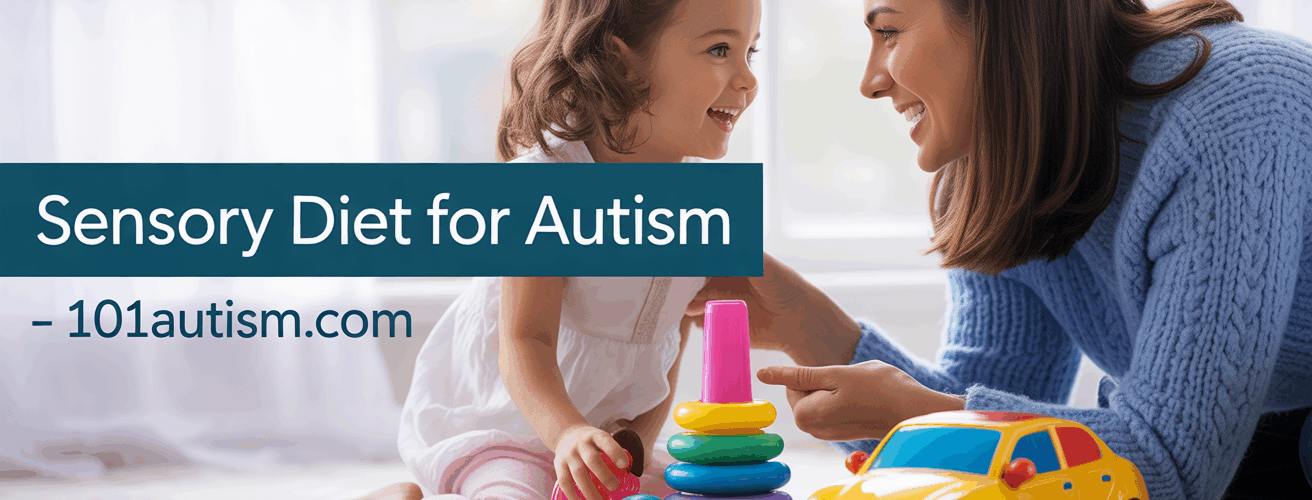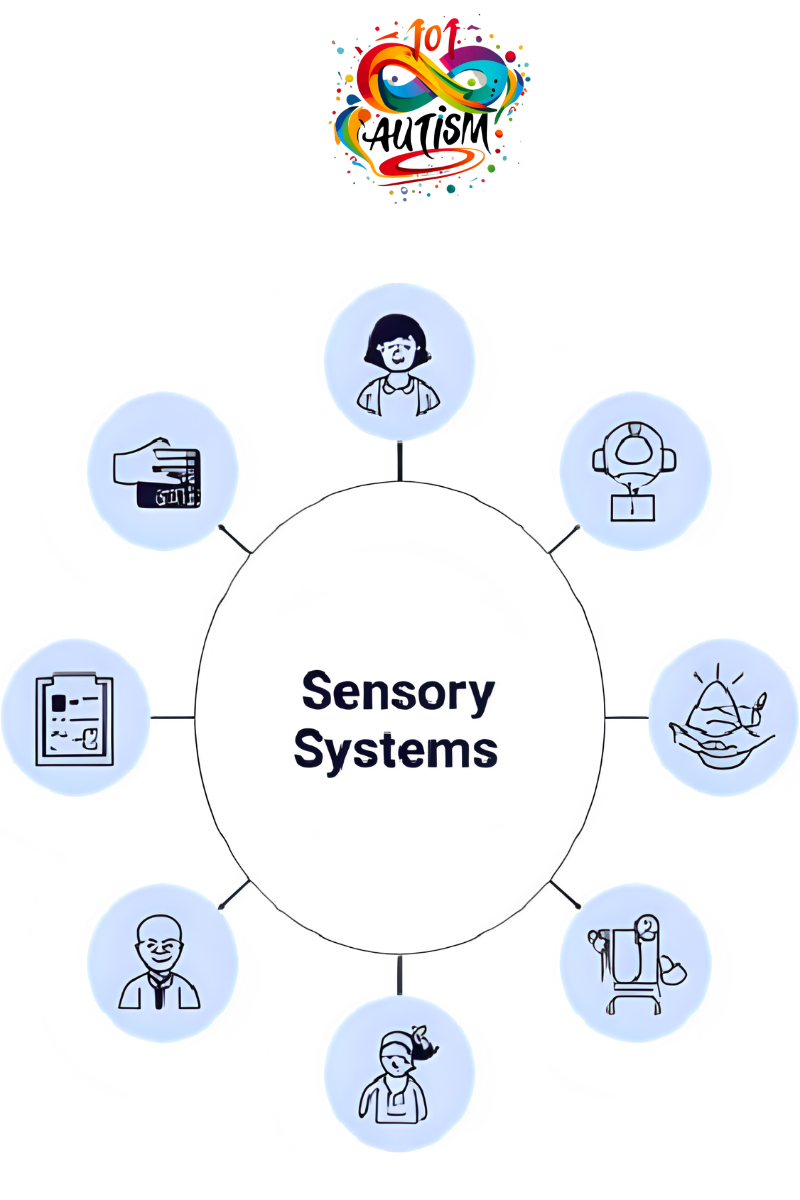Sensory Diet for Autism: Complete Evidence-Based Guide with Interactive Tools

Quick Start Guide
A sensory diet for autism is a personalized daily routine of sensory activities designed to help individuals with autism spectrum disorder regulate their sensory processing and improve focus, behavior, and emotional regulation.
- What it is: Structured sensory activities tailored to individual needs
- Who benefits: Children and adults with autism, ADHD, or sensory processing differences
- Key components: Heavy work, calming activities, alerting exercises, and sensory breaks
- Implementation: Best designed with occupational therapist guidance
- Results: Improved attention, reduced meltdowns, better self-regulation

What is a Sensory Diet for Autism? Understanding the Fundamentals
A sensory diet for autism is a carefully planned sequence of sensory activities designed to meet the unique sensory processing needs of individuals on the autism spectrum. Unlike a food diet, a sensory diet “feeds” the nervous system with the right types and amounts of sensory input to promote optimal functioning throughout the day.
Research Evidence
Studies show that 90% of children with autism experience sensory processing difficulties (Tomchek & Dunn, 2007). Structured sensory diet interventions have demonstrated significant improvements in attention span (45% increase), reduced challenging behaviors (38% decrease), and enhanced participation in daily activities (Miller et al., 2020).
The concept was developed by occupational therapist Patricia Wilbarger, who recognized that just as our bodies need regular nutrition, our sensory systems require consistent, appropriate sensory input to function optimally. For individuals with autism, this need is often heightened due to differences in sensory processing.
The Eight Sensory Systems and Autism
A comprehensive sensory diet for autism addresses all eight sensory systems:
| Sensory System | Function | Common Autism Challenges | Diet Activities |
|---|---|---|---|
| Tactile (Touch) | Processing texture, pressure, temperature | Oversensitivity to textures, seeking deep pressure | Brushing, textured materials, weighted items |
| Proprioceptive (Body Awareness) | Understanding body position and movement | Seeking heavy work, difficulty with coordination | Pushing, pulling, carrying heavy objects |
| Vestibular (Balance) | Processing movement and spatial orientation | Seeking spinning, difficulty with balance | Swinging, spinning, balance activities |
| Visual | Processing sight and visual information | Sensitivity to lights, seeking visual stimulation | Controlled lighting, visual schedules |
| Auditory | Processing sounds and noise | Sound sensitivity, seeking auditory input | Noise-canceling headphones, calming music |
| Gustatory (Taste) | Processing flavors and food textures | Limited food preferences, seeking intense flavors | Oral motor activities, flavor exploration |
| Olfactory (Smell) | Processing scents and odors | Sensitivity to smells, seeking strong scents | Aromatherapy, scent identification games |
| Interoceptive (Internal) | Awareness of internal body signals | Difficulty recognizing hunger, thirst, emotions | Mindfulness, body awareness exercises |

Age-Specific Sensory Diet Strategies
Toddlers (Ages 2-4): Early Sensory Foundation
At this crucial developmental stage, sensory diet for autism focuses on building tolerance and establishing routines. Toddlers with autism often show strong sensory preferences or aversions that can significantly impact daily activities.
Morning Routine Activities
- Heavy Work: Pushing a toy cart filled with books, pulling wagon with stuffed animals
- Proprioceptive Input: Animal walks (bear crawls, crab walks), jumping on mini trampoline
- Calming Activities: Deep pressure hugs, weighted lap pad during breakfast
Transition and Regulation Activities
- Visual schedule with sensory breaks every 30 minutes
- Sensory bin exploration (rice, beans, pasta) for 10-15 minutes
- Oral motor activities: blowing bubbles, drinking through straws
School-Age Children (Ages 5-12): Academic Integration
School-age children need a sensory diet for autism that supports learning readiness and classroom participation. Activities must be practical for home and school environments.
Before School Preparation
- Alerting Activities: 10 jumping jacks, bouncing on therapy ball, upbeat music
- Organizing Input: Wall push-ups, carrying heavy backpack, chair dips
- Calming Preparation: Deep breathing exercises, gentle stretching
During School Strategies
- Fidget tools for proprioceptive input during desk work
- Movement breaks every 20-30 minutes
- Sensory-friendly seating options (therapy ball, standing desk)
- Noise-canceling headphones for auditory sensitivity
After School Regulation
- 30-minute outdoor play with climbing, swinging, running
- Heavy work chores: carrying groceries, moving furniture
- Calming activities: reading in dimmed lighting, gentle music
Teenagers (Ages 13-18): Independence Building
Adolescent sensory diet for autism emphasizes self-advocacy, independence, and managing sensory needs in social situations.
Self-Regulation Strategies
- Teaching self-identification of sensory needs
- Portable sensory toolkit for school and social situations
- Exercise routines for proprioceptive input (weight lifting, yoga)
- Mindfulness and meditation practices for interoceptive awareness
Adults (18+): Workplace and Life Management
Adult sensory diet for autism focuses on workplace accommodations, relationship management, and maintaining daily functioning.
Workplace Strategies
- Ergonomic seating with proprioceptive support
- Scheduled movement breaks every hour
- Noise-canceling headphones for concentration
- Controlled lighting and workspace organization
Interactive Sensory Diet Planning Tool
Personalized Sensory Diet Creator
Answer these questions to generate a customized sensory diet plan:
Step 1: Individual Profile
School-age (5-12 years)
Teenager (13-18 years)
Adult (18+ years)
Step 2: Primary Sensory Challenges (Check all that apply)
Need for heavy work/pressure
Movement seeking or avoidance
Sound sensitivity
Light sensitivity
Attention and focus difficulties
Step 3: Daily Schedule
School/daycare setting
Workplace environment
Mixed environments
Note: This tool provides general guidance. Always consult with an occupational therapist for comprehensive assessment and personalized sensory diet development.
Evidence-Based Sensory Diet Activities by Category
Heavy Work Activities (Proprioceptive Input)
Heavy work activities provide deep pressure input to joints and muscles, helping individuals with autism feel more organized and regulated. These activities are particularly effective for those who seek sensory input.
Indoor Heavy Work Activities
- Wall push-ups: 10-15 repetitions against a wall
- Chair dips: Using a sturdy chair for upper body strengthening
- Carrying tasks: Moving books, laundry baskets, or weighted objects
- Resistance exercises: Using therapy bands or weighted items
- Animal walks: Bear crawls, crab walks, frog jumps
- Yoga poses: Downward dog, child’s pose, warrior poses
Outdoor Heavy Work Activities
- Playground activities: Monkey bars, climbing structures
- Yard work: Raking leaves, digging, pushing wheelbarrow
- Sports activities: Swimming, martial arts, gymnastics
- Bike riding: Provides proprioceptive and vestibular input
Calming Activities (Organizing Input)
Calming activities help reduce overstimulation and anxiety, promoting regulation and readiness for learning or social interaction.
Deep Pressure Activities
- Weighted blankets: 10% of body weight for 20-30 minutes
- Compression garments: Weighted vests or compression shirts
- Deep pressure massage: Using therapy brushes or firm touch
- Tight hugs: Bear hugs or compression between pillows
Environmental Calming Strategies
- Dim lighting: Reduce visual stimulation
- Soft music: Classical or nature sounds
- Aromatherapy: Lavender or vanilla scents
- Quiet spaces: Designated calm-down areas
Alerting Activities (Activating Input)
Alerting activities increase arousal and attention, helpful for individuals who appear sluggish or have difficulty maintaining focus.



1 Response
[…] regulation is one of the biggest challenges for children on the spectrum. When emotions run high, it’s […]